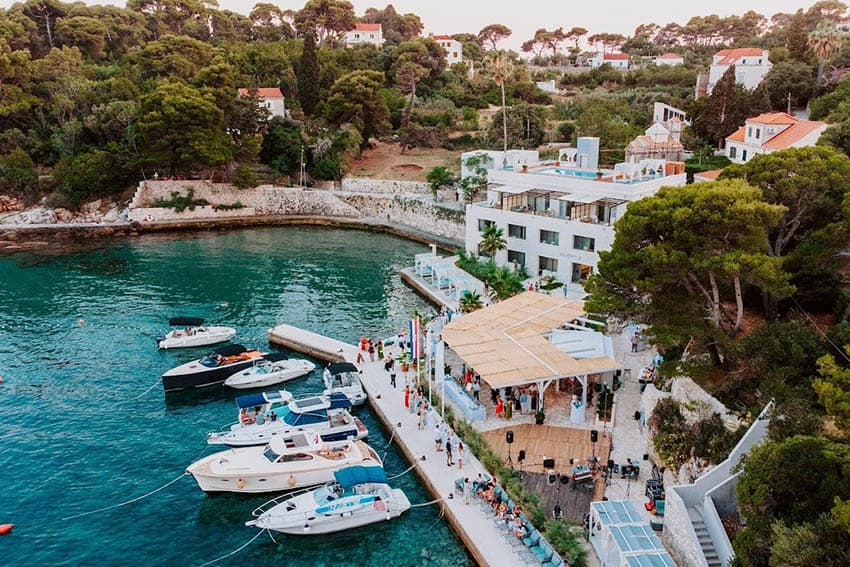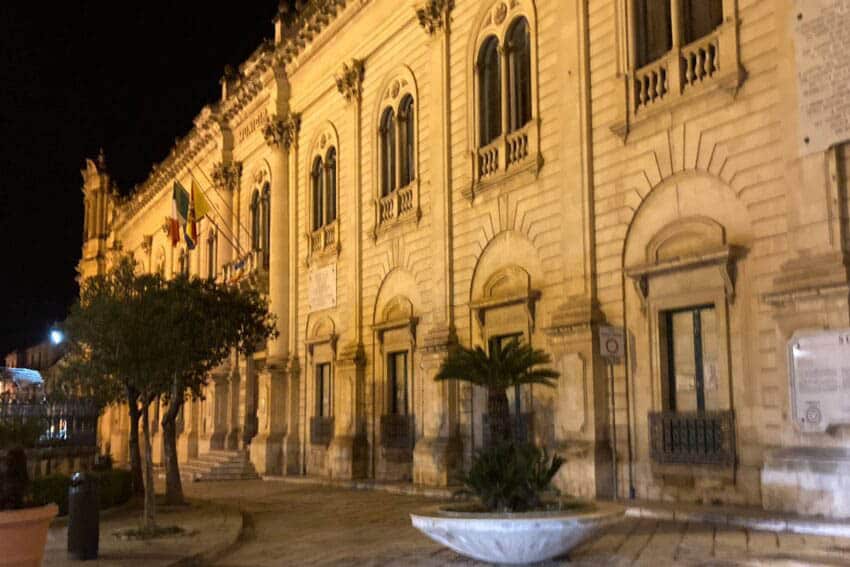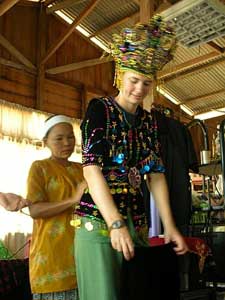
By Alice Driver
“Hello, best friend. I love you too,” children yelled from the road as we drove by in a corroded fuchsia minibus. It was stripped entirely within – a metal box on wheels.
The road was more potholes than pavement, and the bus swerved from side to side as Juanes La Camiseta Negra blared on the radio. After rattling along for ten minutes, my husband Isaac and I arrived in the tiny village of Looksisara on Pulau Bumbun, an island five minutes by boat from Semporna, Malaysia.
Dropped off in the village, we looked around for the house of village leader Haji Suladong, and his family, which would be our home for the next month. Turquoise, orange, cobalt, pink and lilac houses sat on stilts over tidal flats.
We had arrived at high tide, and all the houses were surrounded by water. Plastic bottles, flip flops, candy wrappers, shoes, diapers and other trash floated around the houses; kids played, splashing and laughing in the water.
Goats wandered around the stilted houses dreaming of eating the bougainvilleas flowering on the raised porches and boardwalks. The sound of babies crying and children playing filled the air as women hung out clothes. In front of Haji Suladong’s house was a tiny green mosque.
When I met Haji Suladong and his wife I assumed the term Haji/Haja was equivalent to Mr. and Mrs; to show my respect I began addressing all elders with those titles. It was only later that I discovered the titles were reserved for those who had completed the Haj, the pilgrimage to Mecca.
The Bajau

The island of Bumbun is populated by the Bajau, an indigenous ethnic group that traditionally lived on boats and subsisted from the sea. They have been practicing Muslims since the 15th century when they came under the influence of Muslim traders. Each village on the island has a small, brightly painted mosque.
On our first night when I walked down the boardwalk to the shower the sky was full of stars. Opening the corrugated metal door and stepping inside, I looked through the holes in the plank floor to the sea below.
My head and shoulders rose above the shower, and directly in front of me was the glowing star and crescent moon that decorated the top of the village mosque.
As I dumped buckets of cold water over myself, the Muslim evening call to worship began, chanted over the mosque loudspeaker. This was followed by recitations from the Koran that flowed out into the night air.
The next morning I found Haji Suladong in the front yard killing a goat. The crying of the animal was followed by a moment of silence as the knife sliced the thin white flesh of its neck, and blood ran onto the grass.
I turned away, and realizing how disconnected I was from the source of my daily food. I imagined that we would eat the goat for dinner in a few days. However, we arrived at lunch to find steaming plates of curried goat and onion.
“This is the freshest meat I’ve ever eaten” I thought to myself.

Dancing the Igal
Many nights the neighbors gathered on a back porch facing the sea to play traditional music. Haji Suladong´s six-year-old daughter Tikah and another friend often danced the Igal, a rite traditionally performed on the hand-built Lepa boat.
Though young, the girls were serious and exact in their dancing. Their hands flitted like pairs of butterflies as their bodies swayed rhythmically. The dance is composed of slight but constant movement of the feet, shoulders and hands.
Young boys shouted and ran across the porch in hopes of distracting the girls. However, they kept on dancing, smiles on their faces, their bodies in flight.
One day an old woman came over to visit Haji Sualdong. Standing out on the boardwalk, she stopped and stared at me. Then she walked over and began patting my breasts. I was familiar with this treatment on account of wearing a sports bra.
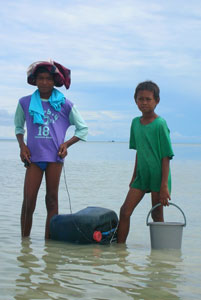
I never knew exactly what the women are saying, but I guessed they were asking me where my breasts were. This woman was so surprised that she patted my breasts several times, looking at me questioningly. I looked down into her wrinkled face and smiled.
A Different View of Personal Space
Going to the bathroom in the village was an adventure. It required walking out to the end of a long dock facing the sea, and squatting over a hole surrounded by tin walls for privacy. Every time I walked by people in the surrounding houses sitting on their porches would ask me “pergi mana?” (“Where are you going”). Kids followed me, curious about what I was doing.
By the time I reached the outhouse over the sea a group of young kids trailed behind me. Being there made me realize that the idea of personal space is very much a Western notion. On Bunbum Island people slept, undressed, ate and went to the bathroom in communal spaces.
Kids often walked in and out of my room when I was changing clothes, and seemed not to understand why I told them to please get out. The fact that rooms in houses on the island had no doors indicated to me how differently they defined personal space.
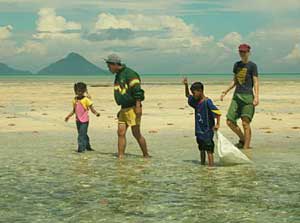
Collecting Mollusks
One Saturday we piled into a traditional Lepa boat with Haji Sualdong and five other family members to go collect mollusks. We motored off into the ocean, navigating our way through rows of seaweed gardens tended by Pilipino workers and occasionally passing by a boat of dynamite fisherman.
After an hour we stopped at a sandbar surrounded by pristine turquoise waters. The sea unfurled before me – cobalt, turquoise, aquamarine – infinite in its palate of blues.
We hopped out with Tikah, Haji Suladong’s daughter, and she started collecting edible mollusks. The shallow water was populated by giant red and black sea stars which looked menacing in such profusion. Tikah gathered sea snails, sea urchins and sea cucumbers and threw them into a sack.
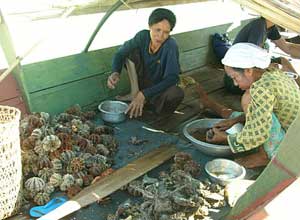
Haji Suladong was out in the water with a large floating bowl tied to his wrist. He filled it with sea urchins and then dumped the prickly creatures on the boat.
We were out there for hours, returning the boat for lunch.
On board I found the two women cracking open sea urchins, pouring the brackish water from inside the urchins overboard and scraping the orange roe into a bowl.
As soon as I got in the boat they offered me the bowl of roe mixed with rice. To my surprise it tasted like a bite of the sea – salty and fresh. Sea cucumber was pulled out of the water, cut up and added to my bowl as I ate.
One afternoon I returned home to find my host mother lying on the floor writhing, eyes rolled back in her head. I could see the look of pain on her face, and feared for her life. I looked around to find Tikah sitting on the couch. She explained calmly that her Mom had always had this problem.
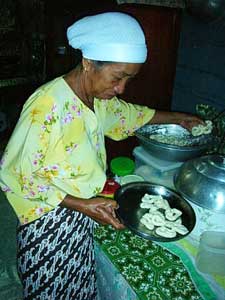
Tikah helped her Mom sit up and watched as she crawled to the porch to vomit. I sat there not knowing what to do and thinking of all the times I’d seen her scrub pots, cook dinner, wash clothes and chop fish.
I looked away, out the door, down the boardwalk to the distant turquoise sea, and by the time I turned around again Tikah and her Mom were gone.
Although I am now back in the United States, I carry memories of the five weeks I spent living on Pulau Bumbun with me. Often I find myself stuck in traffic, and am transported back to the turquoise waters of Pulau Bumbun. Once again I am sitting on the dock at Haji Suladong’s house with Tikah and counting sea snakes.
The light turns green, and I am forced back to my current reality, but memories of my host family – strong, loving and generous – are carried with me.
Respecting Village Culture:
• Make an effort to learn basic Malay before coming to the island, because many residents to not speak English. If you are flying into peninsular Malaysia there is an excellent language school in Penang that offers affordable classes. For more information about classes visit the Dynamic Language Center website or email them.

• Dress modestly. Most residents of Bumbun Island are Muslim, and though women visitors are not expected to cover their heads, visitors should avoid wearing tank tops and shorts or other revealing clothing.
• Politely accept at least a few bites of all food or drink offered to you. It is a way of showing your appreciation of their food and culture.
Resources on village culture:
• To learn more about the Bajau and their current situation consult the book Outcasts of the Islands: The Sea Gypsies of South East Asia (Flamingo 2002).
• For information about the annual Regatta Lepa Festival featuring the traditional boats of the Bajau go to sabahtourism.com or email
 Alice Driver is a PhD student in Hispanic Studies at the University of Kentucky. Her travel writing has appeared in Transitions Abroad, Abroad View, South American Explorer and the travel guide To Vietnam With Love. Her most recent academic article, an interview with Colombian film director Victor Gaviria, will be published in the Arizona Journal of Hispanic Cultural Studies in January of 2009.
Alice Driver is a PhD student in Hispanic Studies at the University of Kentucky. Her travel writing has appeared in Transitions Abroad, Abroad View, South American Explorer and the travel guide To Vietnam With Love. Her most recent academic article, an interview with Colombian film director Victor Gaviria, will be published in the Arizona Journal of Hispanic Cultural Studies in January of 2009.
- Montreal’s Breweries Await Your Thirst - May 7, 2024
- Mother’s Day Ideas - May 6, 2024
- Exploring Kenya’s Night Markets - May 3, 2024


